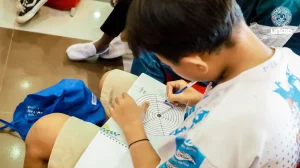One of the things that can accelerate the process of innovation and knowledge creation is through information and knowledge sharing activities. Information sharing can be done in various ways, both directly and through electronic media. Likewise, in the academic world, academicians also take advantage of information sharing to support their academic activities. In the information creation cycle there are several processes such as information acquisition, information filtering, information management and storage, information usage, and new information creation and so on so that a circle of knowledge will be formed. The more information, the more innovation or new knowledge is created. This research uses a quantitative approach by taking a sample of 200 students from Faculty of Vocational Studies Universitas Airlangga. Researchers only distribute questionnaires to students who own and use social media. But the returned and used questionnaires were 154 questionnaires from 70 men and 84 women.
Social Media for Information Sharing
The result of the survey showed that on average students have more than one social media, and some even have more than five social media. The most widely used social media were Instagram, Facebook, Twitter and YouTube. Current social media users are estimated to reach 2 billion and will rise to 2.6 billion in 2018. Based on data collected, the most widely used media by Faculty of Vocational Studies students were Instagram and Facebook. At present, there are more than 60 social media and applications that give users many choices according to their needs. Based on the results of the survey, children aged 18-34 mostly use Facebook, and it was ranked the highest in the world, followed by Snapchat and Instagram (comScore Mediametrics, 2015).
Faculty of Vocational Studies students spend a lot of time accessing social media between 2-4 hours a day. Many even allocate time above 4 hours a day. It shows that they already consider social media to be the second world they must always monitor. But the time allocation is still far below the results of Asano survey, 2017, which stated that teenagers spend 9 hours interacting on social media. Even 30% of teens allocate time throughout the day to interact on social media (Asano, 2017).
The most common activities done when accessing social media are finding information according to the needs of students, uploading photos of their activities, reading the status of others, downloading files, updating statuses, downloading videos and photos, and uploading files. Respondents on average update information, status, videos, photos 1-3 times a day, and some students upload above six times a day. There was 5 percent of respondents rarely upload files on social media. They did not update the information regularly every day. Regarding information updated by respondents, 53% stated that they updated information related to personal matters, 30% related to hobbies, and 9% related to sensational news for example from famous people and information related to politics.
The credibility of Information Sources
Before uploading information, respondents verified the information they got. They verified the contents of information, followed by the origin of the source of information, and the effects arising from the information. There are several sources used by respondents to obtain information, 91% from social media and 69% from the internet and online news sites. Respondents did not take information from scientific articles such as journals, research results, or from textbooks. Based on the survey results, 45% of respondents verified by comparing information from several sources, checking who wrote the information, and looking at the updates of the information.
Although information sharing is not just a process of giving and receiving information, however, in practice, the activity is carried out spontaneously and sometimes the process of giving and receiving information is not clear. In this case, in addition to updating the information in the form of pictures, videos, files, and text of the respondent also play an active role in providing comments on social media. Within a day 75% of respondents answered and commented 1-3 times, some even gave 4-6 comments (28%), and> 6 times as much as 2.5%. Social media is stated as the right media to share information among students. 91% of responses said that social media is easy to use to update various forms of information quickly through gadgets. Accessing social media makes respondents quickly get the information they sought. It makes respondents agreed that social media is very suitable for sharing information.
Author: Nove E. Variant Anna
Details about this research can be found at
https://www.scitepress.org/PublicationsDetail.aspx?ID=JIZ56TatOzI=&t=1









